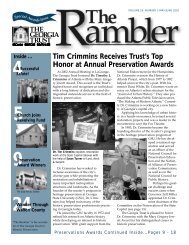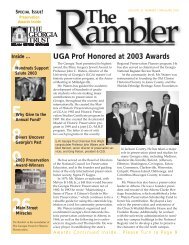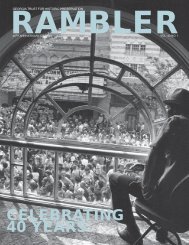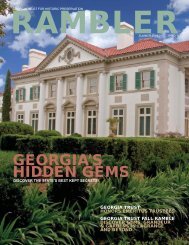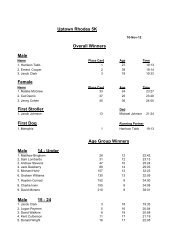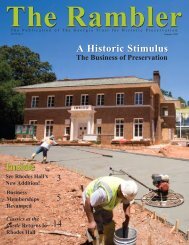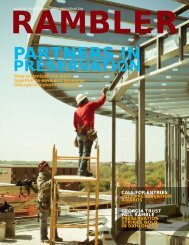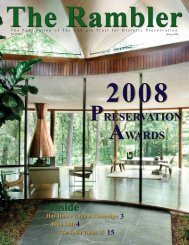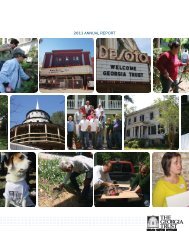May/June 2007 - The Georgia Trust for Historic Preservation
May/June 2007 - The Georgia Trust for Historic Preservation
May/June 2007 - The Georgia Trust for Historic Preservation
You also want an ePaper? Increase the reach of your titles
YUMPU automatically turns print PDFs into web optimized ePapers that Google loves.
Restoration Reveals Original Decorative<br />
Arts Scheme,Original Room Use<br />
As part of the overall restoration plan <strong>for</strong> Hay<br />
House, a team of painting conservators from Atlantabased<br />
IFACS (International Fine Arts Conservation<br />
Services) spent two weeks in February at Macon’s Hay<br />
House. <strong>The</strong> group examined, documented and restored faux<br />
finishes and wood-graining on the mansion’s first-floor service<br />
level and second-floor main level.<br />
<strong>The</strong> analysis yielded several key findings that help us understand<br />
not only the nature of the home’s original decorative<br />
arts scheme, but also the usage of several rooms in the house.<br />
<strong>The</strong> project was spearheaded by IFACS CEO Geoffrey<br />
Steward and implemented by conservators Mary Aldrich and<br />
Andrew Compton. <strong>The</strong> team touched up wood graining in the<br />
Music Room and Double Parlor, as well as the trompe l'oeil<br />
finishes in the Marble Hall and service areas in the basement.<br />
<strong>The</strong> conservators also created a floor mat <strong>for</strong> the small service<br />
hallway between the New Kitchen and Butler's Pantry<br />
that preserves the original painted floor underneath while<br />
interpreting <strong>for</strong> visitors the blue-and-white diamond pattern,<br />
which once indicated to a servant which hallway to use.<br />
On the basement level, the conservators created witness<br />
panels by removing sections of the whitewashed walls to reveal<br />
wood graining and faux finish underneath. In the Scullery, a<br />
basement-level service area between the Old Kitchen and the<br />
back Hallway, a section of a wood-grained dado was revealed<br />
66" from the floor. <strong>The</strong> glazes on top of the painting indicate<br />
the surfaces would have been easily washable with soap and<br />
water. Such new in<strong>for</strong>mation helps rein<strong>for</strong>ce its interpretation<br />
as a service room <strong>for</strong> food preparation, a wash room <strong>for</strong> pots<br />
and pans, and a space <strong>for</strong> the home’s furnace pit.<br />
AROUND THE HOUSES<br />
HAY HOUSE<br />
RHODES HALL<br />
Witness panels in the Larder, or pantry, on the basement<br />
level also provided a glimpse into one of the<br />
most fascinating spaces in the house. <strong>The</strong> only room<br />
with original burglar bars (indicating the value<br />
placed on food in the 1860s), the Larder has shelves<br />
and bins <strong>for</strong> dry food storage that are suspended<br />
from the ceiling to protect the goods from insects and<br />
rodents. Hooks in the ceiling were used to hand-cure meats,<br />
a European tactic that the Johnstons probably saw on their<br />
honeymoon trip. Because the Larder was the singular storage<br />
space in the house, the recent discovery of wood graining<br />
under the whitewash tells us that the Johnston family took<br />
care to decorate and finish even the most private service areas<br />
in the house. After over 150 years, the walls of Hay House are<br />
still telling the story of the original<br />
owner's intent and usage.<br />
Above Left: This<br />
floor cloth will<br />
protect the original painted wooden floor beneath while<br />
interpreting the blue-and-white diamond pattern <strong>for</strong> visitors.<br />
Right: Witness panel of a wood grained dado in the Scullery,<br />
a service area on the basement level.<br />
Rhodes Hall Announces Front Porch<br />
Restoration, New Hours,Tours<br />
On April 13, Phase I of Rhodes Hall's front porch<br />
restoration began with the installation<br />
of seven beautiful European Palms and<br />
terra cotta pots. <strong>The</strong>se purchases were<br />
made possible with funds from the<br />
Peachtree Garden Club.<br />
Phase II of the restoration involves<br />
securing the funds <strong>for</strong> and purchasing<br />
Brumby Rockers as well as outdoor carpets<br />
and other furniture <strong>for</strong> the porch.<br />
If you or your company/organization<br />
is interested in helping us restore<br />
our Peachtree Street porch back to its<br />
original appearance, please call Laraine<br />
Lind at 404-885-7809.<br />
Rhodes Hall’s porch in 1904.<br />
Rhodes Hall is also pleased to announce that we've<br />
expanded our museum hours to include being open to<br />
the public on Saturdays 10 a.m.–2 .pm. We will also<br />
offer the Behind the Scenes tour six days a week.<br />
<strong>The</strong>se additional weekend hours<br />
became effective April 1.<br />
Previously, only the first floor of the<br />
house museum was open Monday to<br />
Friday, 11 a.m.–4 p.m., and the Behind<br />
the Scenes tour was offered exclusively<br />
on Sundays 12 noon–3 p.m. <strong>The</strong>se additional<br />
weekend hours will undoubtedly<br />
serve both the weekend tourist and local<br />
history-seeking public better.<br />
Remember, <strong>Trust</strong> members receive<br />
free admission to both Hay House and<br />
Rhodes Hall! Call 404-885-7809 <strong>for</strong><br />
more in<strong>for</strong>mation.<br />
<strong>The</strong> Rambler, <strong>May</strong>/<strong>June</strong> <strong>2007</strong> 3



